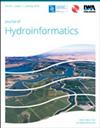Quantile mapping technique for enhancing satellite-derived precipitation data in hydrological modelling: a case study of the Lam River Basin, Vietnam
IF 2.2
3区 工程技术
Q3 COMPUTER SCIENCE, INTERDISCIPLINARY APPLICATIONS
引用次数: 0
Abstract
Accurate precipitation is crucial for hydrological modelling, especially in sparse gauge regions like the Lam River Basin (LRB) in Vietnam. Gridded precipitation data sets derived from satellite and numerical models offer significant advantages in such areas. However, satellite precipitation estimates (SPEs) are subject to uncertainties, especially in high variable of topography and precipitation. This study focuses on enhancing the accuracy of Integrated Multi-satellitE Retrievals for Global Precipitation Measurement (IMERG), Climate Prediction Center morphing technique (CMORPH) using the Quantile Mapping (QM) technique, aligning the cumulative distribution functions of the observed precipitation data with those of the SPEs, and assessing the impact on hydrological predictions. The study highlights that the post-correction IMERG precipitation using QM performs better than other data sets, enhancing the hydrological model's performance for the LRB at different temporal scales. Nash–Sutcliffe efficiency values increased from 0.60 to 0.77, surpassing the original IMERG's 0.52 to 0.74, and correlation coefficients improved from 0.79 to 0.89 (compared with the previous 0.75–0.86) for hydrological modelling. Additionally,Per cent Bias (PBIAS) decreased from approximately −1.66 to −2.21% (contrasting with the initial −20.22 and 4.6%) with corrected SPEs. These findings have implications for water resource management and disaster risk reduction initiatives in Vietnam and other countries.用于在水文建模中增强卫星降水数据的定量绘图技术:越南林河流域案例研究
准确的降水量对水文建模至关重要,尤其是在像越南林河流域(LRB)这样水尺稀少的地区。卫星和数值模型得出的网格降水数据集在这些地区具有显著优势。然而,卫星降水估算(SPEs)存在不确定性,尤其是在地形和降水量变化较大的情况下。本研究的重点是提高全球降水测量多卫星综合检索(IMERG)的精度,利用量子映射(QM)技术提高气候预测中心变形技术(CMORPH)的精度,使观测降水数据的累积分布函数与 SPEs 的累积分布函数相一致,并评估其对水文预测的影响。研究结果表明,使用 QM 对 IMERG 降水量进行校正后,其性能优于其他数据集,从而提高了水文模型在不同时间尺度上对 LRB 的性能。纳什-萨特克利夫效率值从 0.60 提高到 0.77,超过了原始 IMERG 的 0.52 至 0.74,水文建模的相关系数从 0.79 提高到 0.89(之前为 0.75-0.86)。此外,经过校正的 SPEs 的百分比偏差(PBIAS)从约-1.66%降至-2.21%(与最初的-20.22%和 4.6%形成鲜明对比)。这些发现对越南和其他国家的水资源管理和减少灾害风险举措具有重要意义。
本文章由计算机程序翻译,如有差异,请以英文原文为准。
求助全文
约1分钟内获得全文
求助全文
来源期刊

Journal of Hydroinformatics
工程技术-工程:土木
CiteScore
4.80
自引率
3.70%
发文量
59
审稿时长
3 months
期刊介绍:
Journal of Hydroinformatics is a peer-reviewed journal devoted to the application of information technology in the widest sense to problems of the aquatic environment. It promotes Hydroinformatics as a cross-disciplinary field of study, combining technological, human-sociological and more general environmental interests, including an ethical perspective.
 求助内容:
求助内容: 应助结果提醒方式:
应助结果提醒方式:


